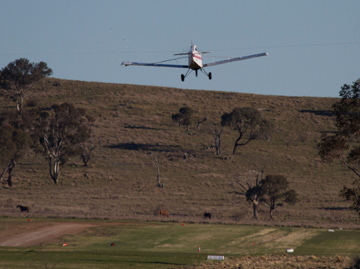
On 20 September 2014, the pilot of a Piper PA-25 aircraft, conducted a ferry flight from Camden to Bunyan aeroplane landing area, via Goulburn, New South Wales.
After refuelling at Goulburn aerodrome, the pilot tracked to overhead Michelago and continued south towards Bunyan. About 10 km south of Michelago, the pilot intended to overfly a private airstrip to assess its condition and suitability as a potential out-landing site for gliders operating from Bunyan.
The aircraft was heading south and as the airstrip was oriented approximately north-south, the pilot elected to overfly the runway. When about 300 m beyond the runway threshold, the aircraft struck powerlines that crossed the runway about 15 m above ground level, dislodging the windscreen and canopy. The top of the fin was severed by the powerlines. Immediately after the strike, the aircraft banked to the left before returning to level flight. The pilot assessed that the aircraft was too high to land ahead on the remaining runway and made a right turn, initially planning to land towards the north on the adjacent paddock. However, due to the rough surface of the paddock and tailwind, he conducted a short downwind leg before turning to the right, and the aircraft landed into wind on the runway.
The top of the fin was severed by the powerlines.
The ability of pilots to detect powerlines depends on the physical characteristics of the powerline and the effect of weather conditions. Powerlines may be invisible to the naked eye. When flying at low altitude, pilots should use additional cues to identify powerlines, such as the power poles and buildings to which the powerlines may connect.
Safety message
Research conducted by the ATSB found that 166 aircraft wirestrikes were reported to the ATSB between July 2003 and mid-June 2011 and another 101 occurred and were unreported but identified by electricity distribution and transmission companies. The majority of wirestrike occurrences were associated with aerial agriculture operations however, 22 occurrences (8 per cent) involved private operations. See the research report AR-2011-004: Under reporting of aviation wirestrikes.
Depending on the environmental conditions, powerlines may not be contrasted against the surrounding environment. Often the wires will blend into the background vegetation and cannot be recognised. In addition, the wire itself can be beyond the resolving power of the eye: that is, the size of the wire and limitations of the eye can mean that it is actually impossible to see the wire. As such, pilots are taught to use additional cues to identify powerlines, such as the associated clearings or easements in trees or fields that can underlie the powerline, or the power poles and buildings to which the powerlines may connect.
The ATSB publication, Avoidable Accidents No. 2 – Wirestrikes involving known wires: A manageable aerial agriculture hazard, advises pilots to always conduct an aerial reconnaissance to confirm wire locations and other hazards.
Risks associated with operations to private airstrips can be mitigated by ALA owners assessing their airstrips against the guidance in CAAP 92-1(1) Guidelines for aeroplane landing areas. Such risk assessments would benefit from giving consideration to first time users of the ALA.


